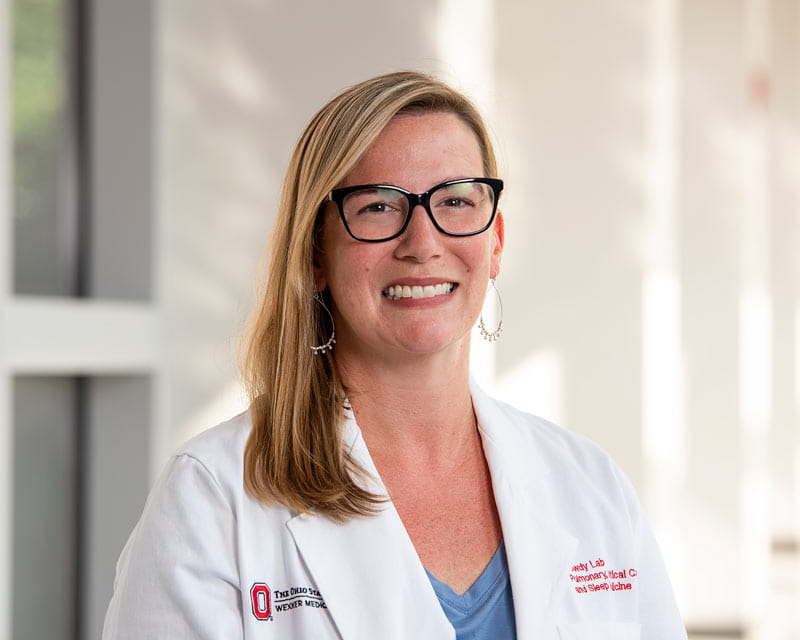
Ohio State Researchers Launch NIH-Funded Study on Ozone-Induced Pulmonary Inflammation
 As scientific and medical institutions around the world rush to discover treatments for COVID-19, researchers at The Ohio State University Wexner Medical Center are doing their part by participating in a clinical trial evaluating the safety and efficacy of convalescent donor plasma.
As scientific and medical institutions around the world rush to discover treatments for COVID-19, researchers at The Ohio State University Wexner Medical Center are doing their part by participating in a clinical trial evaluating the safety and efficacy of convalescent donor plasma.
As one of 50 medical centers taking part in the Passive Immunity Trial for Our Nation to Treat COVID-19 in Hospitalized Adults (PassItOn), the Ohio State Wexner Medical Center aims to help confirm whether convalescent plasma represents a new standard of care for adults hospitalized with the novel coronavirus.
Prior to joining the PassItOn study, physician-scientists in the Ohio State Wexner Medical Center’s Division of Pulmonary, Critical Care and Sleep Medicine offered investigational convalescent plasma through the Expanded Access Program (EAP), a national initiative led by the Mayo Clinic and the Food and Drug Administration (FDA).
“In April 2020, as US hospitals started seeing the first wave of COVID patients needing critical care, the EAP offered a pathway for seriously ill patients to receive plasma therapy outside of a clinical trial,” pulmonologist Sonal Pannu, MD, says. “This was important because there were no adequate alternative therapies available, and early data suggested convalescent plasma may help decrease the severity or length of illness in some hospitalized patients.”
By mid-August, around 80,000 patients were infused through the EAP, including women and people from diverse racial and ethnic backgrounds – populations that tend to be under-represented in clinical research.
After reviewing the safety and efficacy data generated by the EAP and other research activities, the FDA concluded the potential benefits of convalescent plasma outweigh the potential risks. On August 23, it issued an Emergency Use Authorization (EUA) further expanding access to this investigational treatment.
“Under the EUA all hospitals can now use COVID-19 convalescent plasma as long as they follow certain protocols,” Dr. Pannu says. “It gives us a way to use plasma therapy on people who are normally excluded from clinical trials, including pregnant women, patients from correctional facilities and people with certain chronic diseases. However, even with the emergency use authorization, the FDA strongly recommended that medical centers continue enrolling patients in clinical trials.”
Following the FDA’s announcement, Mayo Clinic discontinued EAP enrollment; however, other studies – including the PassItOn trial – picked up where that program left off.
The multicenter PassItOn study, which is led by researchers at Vanderbilt University Medical Center and supported by a $34 million grant from the National Center for Advancing Translational Sciences, is also testing the safety and efficacy of COVID-19 convalescent donor plasma among hospitalized adults.
The results of this 1:1 randomized trial comparing convalescent plasma to a placebo will be measured beginning 14 days after infusion, using a tool called the COVID-19 7-point Ordinal Clinical Progression Outcomes Scale.
Dr. Pannu serves as site co-principal investigator along with fellow pulmonologist Matthew Exline, MD, medical director of the medical intensive-care unit at the Ohio State Wexner Medical Center. She says the trial gives enrolled patients access to convalescent plasma with high antibody titers, which has the capacity to neutralize the virus.
“Anecdotally, we’re seeing that when you give high-titer plasma to people early in their disease, it appears to help – especially compared to low-titer plasma,” Dr. Pannu explains. “However, it’s important that we meet the overall study goal of 1,000 enrolled patients, because we need more evidence to support these preliminary findings.”
Researchers monitor all study participants for 24 hours after infusion for signs of adverse outcomes, including allergic reactions and difficulty breathing. They also assess participants on days 15 and 29 to evaluate symptoms and see how they’re progressing.
All data feeds into a centralized database housed at Vanderbilt that can be accessed in real-time. And, as one of the clinical trials funded by Operation Warp Speed – a public-private partnership created to accelerate the development, manufacturing and distribution of COVID-19 countermeasures – study data are also reported in real-time to the National Institutes of Health.
Dr. Pannu says that now more than ever, it’s critical to support research that helps drive novel treatments.
“In just the first six months of the pandemic, our treatment strategies evolved quite a bit and that’s because of the insights gleaned from clinical trials,” she says. “Convalescent plasma therapy shows promise, but we still lack clear evidence confirming its efficacy. It’s extremely important to understand if high-quality plasma helps COVID-19 patients get better, because we don’t want to subject them to therapies that don’t make a difference.”
To help ensure researchers have adequate access to convalescent plasma, it’s also important for physicians to encourage donations among their patients who have fully recovered from the virus.
“We should help our recovered patients understand that their plasma not only advances our understanding of this disease but can potentially help people who are fighting for their lives,” Dr. Pannu says. "One plasma donor can help more then one COVID patient through a single donation. And they can donate more than once."
Patients who would like to donate plasma should contact their local blood center about options in their area. People in the greater Columbus area may donate directly to the Ohio State Wexner Medical Center.
Learn more about innovations in care and research from the Division of Pulmonary, Critical Care and Sleep Medicine.